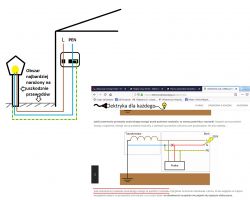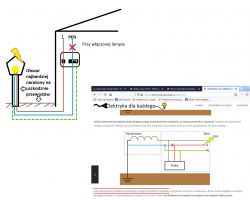Hello.
I am a very beginner in the subject of electricity, so although there are topics on connecting the protective conductor with the neutral in the TN-C network (I have an old installation, without a protective conductor), I would like to present my situation in detail.
I have a lamp in front of the garage, the cable is routed in the ground, in a conduit. I connected the neutral wire to the protective wire which is connected to the metal housing of the lamp. The connection is in a box in the garage.
Is this connection consistent with what I was referring to, i.e. the connection according to? website https://elektrykadlakazdego.pl/uziemienie/
Will this part of the installation be TN-CS?
If for some reason the phase wire touches the housing, in this system the voltage will pass through the housing, through the protective wire to the point of connection with the neutral wire and, causing a short circuit with the phase wire, will blow the fuse (10A).
If the damage to the neutral wire occurs behind the point of connection of the neutral and protective wires, then if the phase wire in the lamp touches the housing, there will be voltage on the housing and nothing will cut it off.

I am a very beginner in the subject of electricity, so although there are topics on connecting the protective conductor with the neutral in the TN-C network (I have an old installation, without a protective conductor), I would like to present my situation in detail.
I have a lamp in front of the garage, the cable is routed in the ground, in a conduit. I connected the neutral wire to the protective wire which is connected to the metal housing of the lamp. The connection is in a box in the garage.
Is this connection consistent with what I was referring to, i.e. the connection according to? website https://elektrykadlakazdego.pl/uziemienie/
Will this part of the installation be TN-CS?
If for some reason the phase wire touches the housing, in this system the voltage will pass through the housing, through the protective wire to the point of connection with the neutral wire and, causing a short circuit with the phase wire, will blow the fuse (10A).
If the damage to the neutral wire occurs behind the point of connection of the neutral and protective wires, then if the phase wire in the lamp touches the housing, there will be voltage on the housing and nothing will cut it off.




